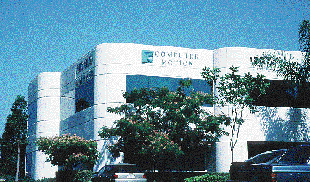GOLDSEA | ASIAMS.NET | ASIAN AMERICAN PERSONALITIES
REMOTE POSSIBILITIES
PAGE 3 of 3
Thanks to a man named Bob Duggan, Wang was able to raise his interest to a commercial footing.
"Duggan is a very successful entrepreneur who has had a number of successes under his belt, and therefore is very wealthy," says Wang. Computer Motion is Bob Duggan's investment. He saw the potential in Wang's circuit architecture and now resides as chairman.
| "I've never been short of confidence." |
With money in the coffers, Wang went scouting for capital and product potentials. At one point, Silicon Graphics expressed serious interest in purchasing the architecture. More grants followed. Chase Equity Partners became a major capital investor.
With the money beginning to flow, Wang pulled in former fellow students from the Center for Robotics. The company did consulting work for Hughes, General Motors, Toyota and others.
Wang showed his 3-D architecture to Pixar, Industrial Light & Magic and Rhythm & Hues. All the while, they searched for product applications.
"I learned a tremendous amount about business," Wang explains, "about where market demands come from, the push and pull of market dynamics. I learned the vast difference between a good idea and a product and a business. Those are miles apart in terms of trying to get from a good idea to a viable business, especially in this area which involves pretty complicated technology."
That's when he discovered the lucrative world of medicine.
"We see robotics and computers revolutionizing how surgery can be performed, therefore really enhancing surgeons' capabilities through improved dexterity, augmenting the number of arms or appendages the surgeon has and being able to directly control his or her environment through voice," says Wang.
Computer Motion is heavily involved in forward-looking product development as opposed to trying to give the AESOP the hard sell. Wang doesn't want it to become a single product-driven company which simply gets swallowed up by bigger players. That's why the company has yet to be profitable. Investing in the future, he stresses, will enable the company to take advantage of such a huge area of potential products. He has the core technology.
And he's about 10 years ahead of anybody else.
Wang has created robotic visualization. But it's only one component towards creating the surgical room of the future. "First you need very steady images and very good control before you can even apply the improved dexterities of instrument manipulation," he says. His newest robot will make procedures like Coronary Artery Bypass Grafting a minimally invasive one. In this procedure, the surgeon uses an alternate blood vessel to bypass a blockage in a coronary artery. To get at the heart, he must first cut open the chest. Wang will allow the surgeon to enter using a minimally invasive technique and manipulate robotic instruments to perform the vessel sewing.
"To do things minimally invasively requires a lot more dexterity," says Wang. "With robotic and computerized instruments we're actually going to be able to bring dexterity to a higher level."
Last January, Yulun brought in his older brother Gene to take over as CEO, leaving himself free to focus on the technical aspect of the operation. Gene came from a business background and has been in charge of some rather sizable corporations--former vice president at Borland, executive vice president of Symantec. The two had been talking about working together for 10 years. It was just a matter of when.

Wang's passion for precision robotics is the foundation for a promising hi-tech venture.
"My best time and energy is focused on product development and marketing," says the younger Wang. During his nearly 12-hour days, you'll find him in the engineering conference room, the engineering lab, his office or "somewhere else."
Wang also has a younger sister, a geotechnical engineer, who works on earthquakes and landslides in Oregon. Surprisingly, Portland lies directly on a fault line. With such a growing high-tech sector and many new buildings going up, she makes sure they're on stable ground.
In retrospect, he remembers thinking that he worked so hard in school and he's amazed because he still had time every day to surf, play tennis or lift weights. In the business world, his free time is very much consumed. Outside of work, he's a family man tried and true. He and his wife, Sue, have two children--Blake Chuanlun, 61/2, and Amber Chuanmei, 31/2. Note the common character in the names. The Wang family has a tradition of a 13 character poem where each successive generation takes the next character of that poem as the first character of their name.
Wang may well be rooted in tradition, but his sights are equally focused towards the horizon. He latches on to and articulates ideas with the finesse of a visionary. He makes a farcical allusion to The Fantastic Voyage, a movie in which a team of scientists are miniaturized then placed inside the human body. But he's in tune with the imagination that created the idea.
"The part I know more about is, say, miniaturizing things. Clearly, we're a long way off and I don't think anybody knows the approaches of how to actually shrink people. The more realistic idea is to make small things which can then bring human perception and dexterity capabilities into those small packages. That is where people are doing research.
"That may be a ways off, but," he emphasizes, "it's going to happen."
CONTACT US
|
ADVERTISING INFO
© 1996-2013 Asian Media Group Inc
No part of the contents of this site may be reproduced without prior written permission.
